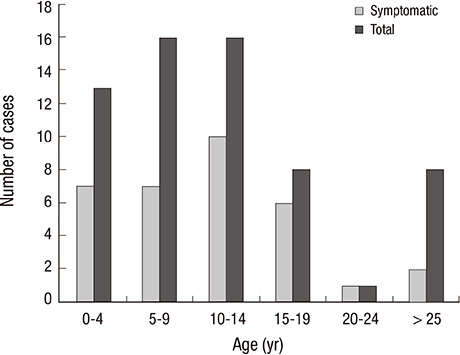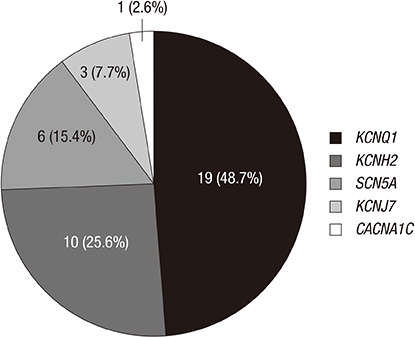J Korean Med Sci.
2013 Oct;28(10):1454-1460. 10.3346/jkms.2013.28.10.1454.
Long QT Syndrome: a Korean Single Center Study
- Affiliations
-
- 1Department of Pediatrics, Seoul National University Boramae Hospital, Seoul, Korea.
- 2Department of Pediatrics, Seoul National University College of Medicine, Seoul, Korea. eunjbaek@snu.ac.kr
- 3Department of Internal Medicine, Seoul National University College of Medicine, Seoul, Korea.
- 4Department of Laboratory Medicine, Seoul National University College of Medicine, Seoul, Korea.
- KMID: 1777681
- DOI: http://doi.org/10.3346/jkms.2013.28.10.1454
Abstract
- The long QT syndrome (LQTS) is a rare hereditary disorder in which affected individuals have a possibility of ventricular tachyarrhythmia and sudden cardiac death. We investigated 62 LQTS (QTc > or = 0.47 sec) and 19 family members whose genetic study revealed mutation of LQT gene. In the proband group, the modes of presentation were ECG abnormality (38.7%), aborted cardiac arrest (24.2%), and syncope or seizure (19.4%). Median age of initial symptom development was 10.5 yr. Genetic studies were performed in 61; and mutations were found in 40 cases (KCNQ1 in 19, KCNH2 in 10, SCN5A in 7, KCNJ2 in 3, and CACNA1C in 1). In the family group, the penetrance of LQT gene mutation was 57.9%. QTc was longer as patients had the history of syncope (P = 0.001), ventricular tachycardia (P = 0.017) and aborted arrest (P = 0.010). QTc longer than 0.508 sec could be a cut-off value for major cardiac events (sensitivity 0.806, specificity 0.600). Beta-blocker was frequently applied for treatment and had significant effects on reducing QTc (P = 0.007). Implantable cardioverter defibrillators were applied in 6 patients. Congenital LQTS is a potentially lethal disease. It shows various genetic mutations with low penetrance in Korean patients.
Keyword
MeSH Terms
-
Adolescent
Adult
Aged
Aged, 80 and over
Asian Continental Ancestry Group/genetics
Calcium Channels/genetics
Child
Child, Preschool
Electrocardiography
Heart Arrest/genetics/pathology
Humans
Infant
KCNQ1 Potassium Channel/genetics
KCNQ2 Potassium Channel/genetics
Long QT Syndrome/*diagnosis/*genetics
Middle Aged
Mutation/*genetics
NAV1.5 Voltage-Gated Sodium Channel/genetics
Penetrance
Potassium Channels, Inwardly Rectifying/genetics
Republic of Korea
Risk Factors
Seizures/genetics/pathology
Young Adult
Calcium Channels
KCNQ1 Potassium Channel
KCNQ2 Potassium Channel
NAV1.5 Voltage-Gated Sodium Channel
Potassium Channels, Inwardly Rectifying
Figure
Cited by 1 articles
-
Clinical and Genetic Features of Korean Inherited Arrhythmia Probands
Joo Hee Jeong, Suk-Kyu Oh, Yun Gi Kim, Yun Young Choi, Hyoung Seok Lee, Jaemin Shim, Yae Min Park, Jun-Hyung Kim, Yong-Seog Oh, Nam-Ho Kim, Hui-Nam Pak, Young Keun On, Hyung Wook Park, Gyo-Seung Hwang, Dae-Kyeong Kim, Young-Ah Park, Hyoung-Seob Park, Yongkeun Cho, Seil Oh, Jong-Il Choi, Young-Hoon Kim
Korean Circ J. 2023;53(10):693-707. doi: 10.4070/kcj.2023.0083.
Reference
-
1. Moss AJ. Long QT syndrome. JAMA. 2003; 289:2041–2044.2. Goldenberg I, Zareba W, Moss AJ. Long QT Syndrome. Curr Probl Cardiol. 2008; 33:629–694.3. Jervell A, Lange-Nielsen F. Congenital deaf-mutism, functional heart disease with prolongation of the Q-T interval and sudden death. Am Heart J. 1957; 54:59–68.4. Romano C, Gemme G, Pongiglione R. Rare cardiac arrhythmias of the pediatric age: II syncopal attacks due to paroxysmal ventricular fibrillation: (presentation of 1st case in Italian pediatric literature). Clin Pediatr (Bologna). 1963; 45:656–683.5. Ward OC. A new familial cardiac syndrome in children. J Ir Med Assoc. 1964; 54:103–106.6. Bokil NJ, Baisden JM, Radford DJ, Summers KM. Molecular genetics of long QT syndrome. Mol Genet Metab. 2010; 101:1–8.7. Schwartz PJ. Idiopathic long QT syndrome: progress and questions. Am Heart J. 1985; 109:399–411.8. Schwartz PJ, Moss AJ, Vincent GM, Crampton RS. Diagnostic criteria for the long QT syndrome: an update. Circulation. 1993; 88:782–784.9. Goldenberg I, Moss AJ. Long QT syndrome. J Am Coll Cardiol. 2008; 51:2291–2300.10. Moss AJ, Schwartz PJ. 25th anniversary of the International Long-QT Syndrome Registry: an ongoing quest to uncover the secrets of long-QT syndrome. Circulation. 2005; 111:1199–1201.11. Kim JH, Nam GB, Kim HK, Rhee KS, Han KH, Choi KJ, Ko JK, Park IS, Kim YH. Clinical and electrocardiographic features of patients with congenital long QT syndrome. Korean Circ J. 2002; 32:798–806.12. Hyun DW, Kim YN, Han SW, Jo YK, Shin DG, Cha TJ, Lee SM, Kim JS, Cho JG, You KH, et al. Moleculogenetic characteristics of the patient with long QT syndrome in Korean. Korean Circ J. 2004; 34:813–819.13. Song MK, Bae EJ, Baek JS, Kwon BS, Kim GB, Noh CI, Choi JY, Park SS. QT prolongation and life threatening ventricular tachycardia in a patient injected with intravenous meperidine (demerol(R)). Korean Circ J. 2011; 41:342–345.14. Garson A Jr, Dick M 2nd, Fournier A, Gillette PC, Hamilton R, Kugler JD, van Hare GF 3rd, Vetter V, Vick GW 3rd. The long QT syndrome in children: an international study of 287 patients. Circulation. 1993; 87:1866–1872.15. Moss AJ, Schwartz PJ, Crampton RS, Tzivoni D, Locati EH, MacCluer J, Hall WJ, Weitkamp L, Vincent GM, Garson A Jr, et al. The long QT syndrome: prospective longitudinal study of 328 families. Circulation. 1991; 84:1136–1144.16. Goldenberg I, Moss AJ, Peterson DR, McNitt S, Zareba W, Andrews ML, Robinson JL, Locati EH, Ackerman MJ, Benhorin J, et al. Risk factors for aborted cardiac arrest and sudden cardiac death in children with the congenital long-QT syndrome. Circulation. 2008; 117:2184–2191.17. Hobbs JB, Peterson DR, Moss AJ, McNitt S, Zareba W, Goldenberg I, Qi M, Robinson JL, Sauer AJ, Ackerman MJ, et al. Risk of aborted cardiac arrest or sudden cardiac death during adolescence in the long-QT syndrome. JAMA. 2006; 296:1249–1254.18. Drici MD, Burklow TR, Haridasse V, Glazer RI, Woosley RL. Sex hormones prolong the QT interval and downregulate potassium channel expression in the rabbit heart. Circulation. 1996; 94:1471–1474.19. Boyle MB, MacLusky NJ, Naftolin F, Kaczmarek LK. Hormonal regulation of K+-channel messenger RNA in rat myometrium during oestrus cycle and in pregnancy. Nature. 1987; 330:373–375.20. Priori SG, Napolitano C, Schwartz PJ, Grillo M, Bloise R, Ronchetti E, Moncalvo C, Tulipani C, Veia A, Bottelli G, et al. Association of long QT syndrome loci and cardiac events among patients treated with beta-blockers. JAMA. 2004; 292:1341–1344.21. Zareba W, Moss AJ, Schwartz PJ, Vincent GM, Robinson JL, Priori SG, Benhorin J, Locati EH, Towbin JA, Keating MT, et al. Influence of genotype on the clinical course of the long-QT syndrome: International Long-QT Syndrome Registry Research Group. N Engl J Med. 1998; 339:960–965.22. Moss AJ, Zareba W, Benhorin J, Locati EH, Hall WJ, Robinson JL, Schwartz PJ, Towbin JA, Vincent GM, Lehmann MH. ECG T-wave patterns in genetically distinct forms of the hereditary long QT syndrome. Circulation. 1995; 92:2929–2934.23. Zhang L, Timothy KW, Vincent GM, Lehmann MH, Fox J, Giuli LC, Shen J, Splawski I, Priori SG, Compton SJ, et al. Spectrum of ST-T-wave patterns and repolarization parameters in congenital long-QT syndrome: ECG findings identify genotypes. Circulation. 2000; 102:2849–2855.24. Sauer AJ, Moss AJ, McNitt S, Peterson DR, Zareba W, Robinson JL, Qi M, Goldenberg I, Hobbs JB, Ackerman MJ, et al. Long QT syndrome in adults. J Am Coll Cardiol. 2007; 49:329–337.25. Schwartz PJ, Priori SG, Spazzolini C, Moss AJ, Vincent GM, Napolitano C, Denjoy I, Guicheney P, Breithardt G, Keating MT, et al. Genotype-phenotype correlation in the long-QT syndrome: gene-specific triggers for life-threatening arrhythmias. Circulation. 2001; 103:89–95.26. Splawski I, Shen J, Timothy KW, Lehmann MH, Priori S, Robinson JL, Moss AJ, Schwartz PJ, Towbin JA, Vincent GM, et al. Spectrum of mutations in long-QT syndrome genes: KVLQT1, HERG, SCN5A, KCNE1, and KCNE2. Circulation. 2000; 102:1178–1185.27. Schwartz PJ, Locati E. The idiopathic long QT syndrome: pathogenetic mechanisms and therapy. Eur Heart J. 1985; 6:103–114.28. Goldenberg I, Bradley J, Moss A, McNitt S, Polonsky S, Robinson JL, Andrews M, Zareba W. International LQTS Registry Investigators. Beta-blocker efficacy in high-risk patients with the congenital long-QT syndrome types 1 and 2: implications for patient management. J Cardiovasc Electrophysiol. 2010; 21:893–901.29. Gemma LW, Ward GM, Dettmer MM, Ball JL, Leo PJ, Doria DN, Kaufman ES. β-blockers protect against dispersion of repolarization during exercise in congenital long-QT syndrome type 1. J Cardiovasc Electrophysiol. 2011; 22:1141–1146.30. Moss AJ, Zareba W, Hall WJ, Schwartz PJ, Crampton RS, Benhorin J, Vincent GM, Locati EH, Priori SG, Napolitano C, et al. Effectiveness and limitations of beta-blocker therapy in congenital long-QT syndrome. Circulation. 2000; 101:616–623.31. Kaltman JR, Ro PS, Stephens P, McBride MG, Cohen MI, Tanel RE, Vetter VL, Rhodes LA. Effects of beta-adrenergic antagonists on the QT measurements from exercise stress tests in pediatric patients with long QT syndrome. Pediatr Cardiol. 2003; 24:553–558.32. Wong JA, Gula LJ, Klein GJ, Yee R, Skanes AC, Krahn AD. Utility of treadmill testing in identification and genotype prediction in long-QT syndrome. Circ Arrhythm Electrophysiol. 2010; 3:120–125.
- Full Text Links
- Actions
-
Cited
- CITED
-
- Close
- Share
- Similar articles
-
- Implantable Cardioverter-Defibrillator(ICD) Therapy in a Patient with the Long QT Syndrome
- Anesthetic Management of a Patient with Congenital Long QT Syndrome: A case report
- Cardiac Arrest under Anesthesia in a Child with Previously Undiagnosed Long QT Syndrome: A case report
- Fever-Induced QTc Prolongation and Ventricular Fibrillation in a Healthy Young Man
- A Case of Congenital Long QT Syndrome with Reccurent Syncope




